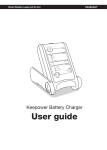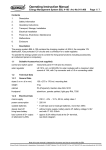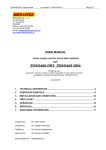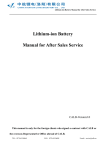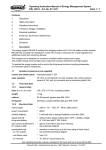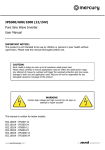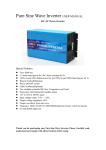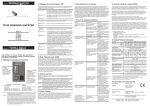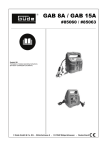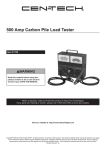Download Harbor Freight Tools 91129 User's Manual
Transcript
500 AMP LOAD TESTER 91129 ASSEMBLY AND OPERATING INSTRUCTIONS ® 3491 Mission Oaks Blvd., Camarillo, CA 93011 Visit our Web site at http://www.harborfreight.com TO PREVENT SERIOUS INJURY, READ AND UNDERSTAND ALL WARNINGS AND INSTRUCTIONS BEFORE USE. Copyright © 2004 by Harbor Freight Tools®. All rights reserved. No portion of this manual or any artwork contained herein may be reproduced in any shape or form without the express written consent of Harbor Freight Tools. For technical questions and replacement parts, please call 1-800-444-3353 Specifications Item Testing Capability Load Test Capacity Display Meters Test Cycle Battery Cable / Clamps Overall Dimensions Weight Features Description 12 VDC batteries, alternators, starters 160 amp hour; Up to 1000 cold cranking amps maximum testing; 0 ~ 500A load Analog, 0~16 VDC (maximum) Analog, 0~500A; 0~160AH; 0~1000 CCA 15 seconds per test with 1 minute cool down; 3 tests in 5 minutes 3 (L) feet, copper plated clamps, # 4 AWG 10-1/2 (W) x 9 (H) x 5 (D) inches 8.7 lbs. Carrying handle and four rubber feet Save This Manual You will need the manual for the safety warnings and precautions, assembly instructions, operating and maintenance procedures, parts list and diagram. Keep your invoice with this manual. Write the invoice number on the inside of the front cover. Keep the manual and invoice in a safe and dry place for future reference. General Safety Warnings and Precautions WARNING: When using tool, basic safety precautions should always be followed to reduce the risk of personal injury and damage to equipment. Read all instructions before using this tool! 1. Keep work area clean. Cluttered areas invite injuries. 2. Observe work area conditions. Do not use machines or power tools in damp or wet locations. Don’t expose to rain. Keep work area well lit. Do not use electrically powered tools in the presence of flammable gases or liquids. 3. Keep children away. Children must never be allowed in the work area. Do not let them handle machines, tools, or extension cords. 4. Store idle equipment. When not in use, tools must be stored in a dry location to inhibit rust. Always lock up tools and keep out of reach of children. 5. Use the right tool for the job. Do not attempt to force a small tool or attachment to do the work of a larger industrial tool. There are certain applications for which this tool was designed. It will do the job better and more safely at the rate for which it was intended. Do not modify this tool and do not use this tool for a purpose for which it was not intended. 6. Dress properly. Do not wear loose clothing or jewelry as they can be caught in moving parts. Protective, electrically non-conductive clothes and non-skid footwear are recommended when working. Wear restrictive hair covering to contain long hair. SKU 91129 For technical questions, please call 1-800-444-3353. Page 2 7. Use eye and ear protection. Always wear ANSI approved impact safety goggles. Wear an ANSI approved dust mask or respirator when working around metal, wood, and chemical dusts and mists. 8. Do not overreach. Keep proper footing and balance at all times. Do not reach over or across running machines. 9. Maintain tools with care. Inspect tool cords periodically and, if damaged, have them repaired by a qualified technician. The handles must be kept clean, dry, and free from oil and grease at all times. 10. Disconnect power. Disconnect Load Tester from battery when not in use. 11. Stay alert. Watch what you are doing, use common sense. Do not operate any tool when you are tired. 12. Check for damaged parts. Before using any tool, any part that appears damaged should be carefully checked to determine that it will operate properly and perform its intended function. Check for any broken parts and any other condition that may affect proper operation. Any part that is damaged should be properly repaired or replaced by a qualified technician. Do not use the tool if any switch does not turn On and Off properly. 13. Guard against short circuits. Never make contact between battery terminals with anything metal during load testing. 14. Replacement parts and accessories. When servicing, use only identical replacement parts. Use of any other parts will void the warranty. Only use accessories intended for use with this tool. Approved accessories are available from Harbor Freight Tools. 15. Do not operate tool if under the influence of alcohol or drugs. Read warning labels if taking prescription medicine to determine if your judgment or reflexes are impaired while taking drugs. If there is any doubt, do not operate the tool. 16. Maintenance. For your safety, service and maintenance should be performed regularly by a qualified technician. 17. People with pacemakers should consult their physician(s) before using this product. Electromagnetic fields, caused by running engines, in close proximity to a heart pacemaker could cause interference to or failure of the pacemaker. In addition, people with pacemakers should adhere to the following: • Caution is necessary when near the coil, spark plug cables, or distributor of a running engine. The engine should always be off if adjustments are to be made to the distributor. Specific Safety Precautions for the Load Tester 1. When connecting the Battery Cables to the battery, avoid creating sparks; especially when the battery is being charged. Explosive gases are created during charging. Sparking could also damage the vehicle electrical system. SKU 91129 For technical questions, please call 1-800-444-3353. Page 3 2. Do not touch the cooling vents on the Load Tester during or immediately after testing the battery. They become very hot. 3. When placing the Load Tester in the vehicle’s engine compartment, take special care that the metal housing of the Tester does not come in contact with either terminal of the battery or other electrical connections. 4. Be certain of the test battery polarity before connecting the test Cable Clamps. The red Cable Clamp goes to the positive terminal of the battery. The black Cable Clamp goes to the negative terminal of the battery. Reversing Load Tester Cable Clamps on the battery will damage the tester. 5. Do not drop the Load Tester as it may affect proper operation. 6. Do not smoke or have open flames near the battery. 7. Do not connect the Load Tester to the battery while the engine is running. Turn the engine off before connecting. Warning: The warnings, cautions, and instructions discussed in this instruction manual cannot cover all possible conditions and situations that may occur. It must be understood by the operator that common sense and caution are factors which cannot be built into this product, but must be supplied by the operator. Unpacking When unpacking, check to make sure that all the parts are included. Refer to the Assembly section, and the Assembly Drawing and Parts List at the end of this manual. If any parts are missing or broken, please call Harbor Freight Tools at the number on the cover of this manual as soon as possible. (B) Black Cable: Clamp to Battery Negative (-) Terminal (A) Red Cable: Clamp to Battery Positive (+) Terminal SKU 91129 For technical questions, please call 1-800-444-3353. Page 4 Operation Testing the Battery 1. Wipe the battery terminals with a cloth to remove any dirt and grease. 2. Make sure the Load Knob (C) is in the off position. Connect the red (positive) Cable Clamp (A) to the positive terminal (+) on the 12 V battery. See photo on page 4. 3. Connect the black (negative) Cable Clamp (B) to the negative terminal (–) on the battery. 4. Turn the Load Knob (C) clockwise until the DC ammeter reads 1/2 the Cold Crank Amp (CCA) rating or three times the amphour (AH) capacity of the battery. The CCA and AH rating are printed on the battery label. Maintain load for 15 seconds to simulate an actual load on the battery. After 15 seconds has passed, the unit will sound with a beep. 5. View the DC Volts Meter and read the battery condition. Refer to the “Battery Condition Analysis” section on the next page. 6. Turn the Load Knob (C) counterclockwise to Off, and remove the Cable Clamps from the battery. Note: Freezing temperatures affect the battery test reading. Decrease the battery rating 50 cold cranking amps for each 50°F (10°C) below freezing 30°F (0°C). Battery Test: Green - OK Red - Replace Amps Scale Amp Hour Scale State of Charge: Green - OK Red - Recharge CCA Scale Alternator & Regulator Test: Green - OK Red - Low Load Knob (C) Negative Cable (-) SKU 91129 Positive Cable (+) For technical questions, please call 1-800-444-3353. Page 5 Testing the Charging System 1. Turn the Load Knob (C) counterclockwise to the Off position. 2. Connect the Cable Clamps to the battery as previously described. Avoid Carbon Monoxide poisoning. This gas comes from the vehicle’s exhaust and is colorless and odorless. It can cause SERIOUS INJURY or DEATH if inhaled. 3. Outside, or in a well ventilated area, start the vehicle engine and run at fast idle speed. 4. View the DC Volt Meter and read the Alt. - Reg. condition. Refer to the “Battery Condition Analysis” section below. 5. Turn the vehicle’s engine off, then remove the Load Tester Cable Clamps. Battery Condition Analysis LOAD TEST / 15 Sec. (Display Reading) OK (Green area) BAD (Red area) CHARGING SYSTEM (Alt. & Reg. Test) SKU 91129 BATTERY CONDITION Battery capacity is good. May or may not be fully charged. Check the charge state by testing the Specific Gravity (SG) with a Hydrometer. If SG is less than full charge, check for possible charging system trouble. Recharge to full level. If the DC Volt Meter needle is falling, the battery is defective or has a bad cell. For a quick check, turn the Load Knob down, counterclockwise and note DC Volt Meter reaction. If voltage recovers to its full potential after only a few seconds, the battery is probably defective. If the voltage recovers slowly, the battery may only be run down. Check specific gravity level, recharge, and re-test. If the DC Volt Meter needle reads OK, charging system is functional. If it falls on the low red or high red areas, charging system may be malfunctioning. For technical questions, please call 1-800-444-3353. Page 6 Starter Motor Test If starting your vehicle is difficult, you may have unnecessary starter motor draw, which dramatically shortens battery life. This test identifies starter motor performance. 1. Make sure your engine is running at normal operating temperature, and that the battery is fully charged and in good condition. 2. Connect the Red Clamp (+) to the positive (+) terminal post on the battery. Connect the Black Clamp (-) to the negative (-) terminal post on the battery. 3. Turn the Load Knob (C) counterclockwise to the Off position. 4. Disable the engine to make sure the car will not start. Refer to your vehicle’s service / technical manual. 5. While watching the DC Volt scale (see page 6), crank the engine briefly to determine the voltage reading during cranking. A display reading of 9 volts or less indicates excessive current draw. This may be caused by a bad connection of a failing starter motor, or, the battery is too small for the vehicle’s requirements. Consult a qualified mechanic. 6. When starter motor test is complete, remove Black Clamp (-) from battery first; then remove Red (+) clamp. INSPECTION, MAINTENANCE, AND CLEANING 1. Periodically check all nuts, bolts, and screws for tightness. 2. Store in a clean, dry location. 3. Clean the outside of the unit with a damp cloth. Never use solvents to clean any parts of this tool. Use compressed air to blow out debris from the load vents. Allow tool to dry completely before use. 4. After each use, clean the Cable Clamps of any possible battery electrolyte. Apply a thin coat of silicon grease to prevent corrosion. Replaceable Parts The Carbon Pile Load Tester has no replaceable parts. REV 04/05 SKU 91129 For technical questions, please call 1-800-444-3353. Page 7







